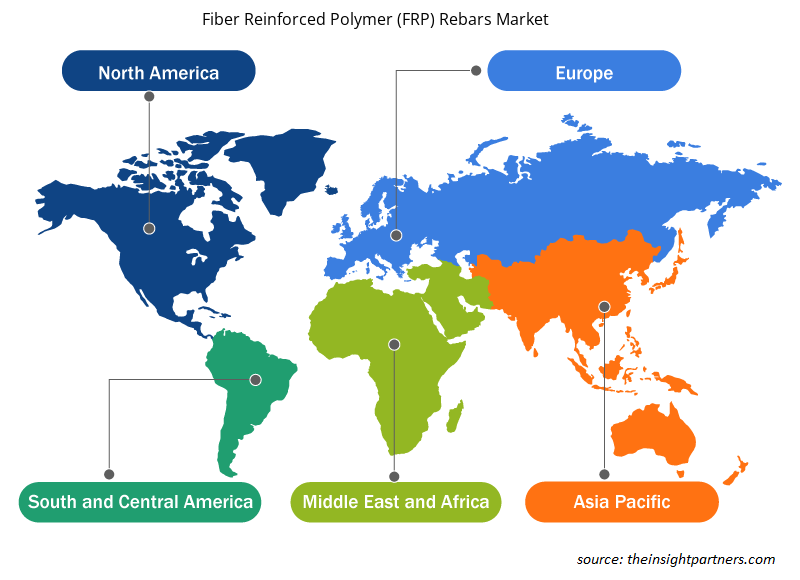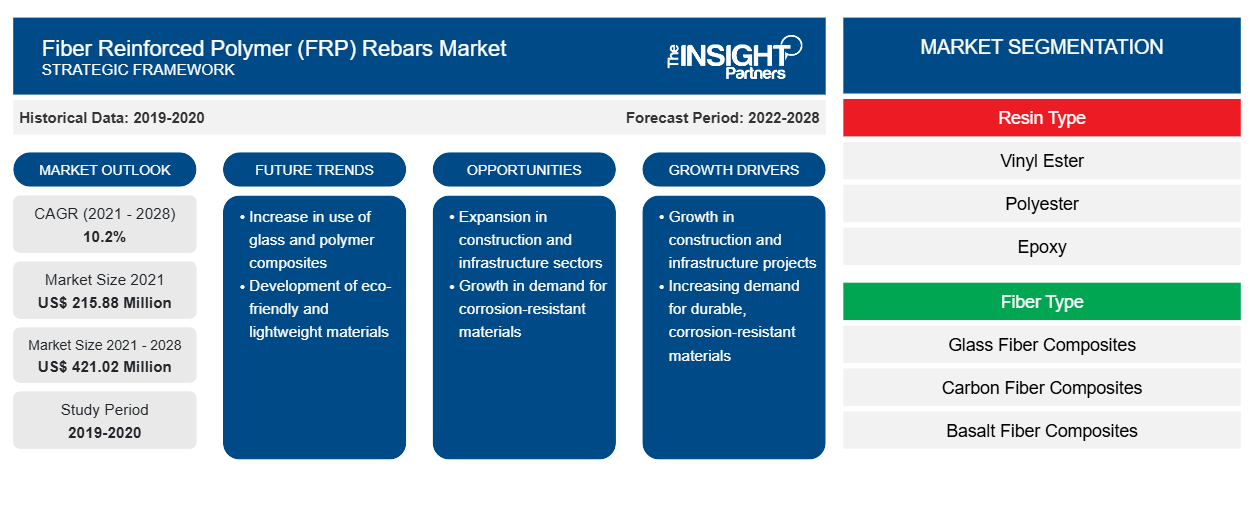纤维增强聚合物 (FRP) 钢筋市场预计将从 2021 年的 2.1588 亿美元增长到 2028 年的 4.2102 亿美元;预计 2022 年至 2028 年的复合年增长率为 10.2%。
由于混凝土抗压强度高而抗拉强度低,因此通常会对其进行强化,以制造出抗拉强度高的建筑材料。这种钢筋通常由钢材制成,因为钢材成本低、强度高、弹性大。然而,钢材腐蚀可能会使政府和资产所有者在更换或修复老化基础设施的维护成本上花费数十亿美元。可用于防止腐蚀的混凝土增强材料替代品很少。例如,一些制造商提供不锈钢钢筋;然而,纤维增强聚合物钢筋可以作为混凝土加固用传统钢筋的无腐蚀替代品。这些 FRP 钢筋由聚合物基质与玻璃、碳或玄武岩纤维结合而成。这些材料不会生锈,比钢轻得多,不传热,抗拉强度几乎是钢的四倍。防腐蚀能力使纤维增强聚合物成为挡土墙、桥墩、防波堤、码头、沉箱、甲板、舱壁、打桩、运河、海上平台、游泳池和水族馆等各种建筑应用的最佳替代品。
此外,在电磁敏感应用中,FRP 钢筋的玻璃和聚合物非导电特性不会传输电流、吸引雷击或干扰附近电气设备的运行。这使得纤维增强聚合物成为铝和铜冶炼厂、机场塔、核电站、专业军事建筑、电力和电话传输塔、包含电气或电话设备的检修孔以及配备磁共振成像 (MRI) 设备的医院中钢材的更安全替代品。
定制此报告以满足您的需求
您可以免费定制任何报告,包括本报告的部分内容、国家级分析、Excel 数据包,以及为初创企业和大学提供优惠和折扣
- 获取此报告的关键市场趋势。这个免费样品将包括数据分析,从市场趋势到估计和预测。
市场洞察
不断增长的建筑活动推动纤维增强聚合物 (FRP) 钢筋市场增长
建筑业是全球经济发展的主要贡献者之一。由于各国政府加大对基础设施建设的支持,建筑业正在迅速蓬勃发展。例如,印度计划在 2019 年至 2023 年期间通过国家基础设施管道在基础设施上投入 1.4 万亿美元。在这一管道中,政府已将电力、桥梁、水坝、道路和城市基础设施建设等基础设施纳入其中。由于纤维增强聚合物具有强度高、耐霜冻和除冰盐、安装时间短、交通干扰最小等优势材料特性,纤维增强聚合物已发展成为桥梁结构的宝贵替代建筑材料。各国政府的此类举措预计将推动纤维增强聚合物 (FRP) 钢筋市场的增长
树脂类型洞察
根据树脂类型,全球纤维增强聚合物 (FRP) 钢筋市场细分为乙烯基酯、聚酯、环氧树脂等。2021 年,乙烯基酯细分市场占有最大市场份额。乙烯基酯树脂强度高;耐腐蚀、耐燃料、耐化学品或耐蒸汽;并提供机械韧性。它们具有出色的耐用性、耐热性和高拉伸伸长强度。这种树脂可以浸渍短玻璃纤维或碳纤维以生产 FRP 钢筋。大多数纤维增强聚合物钢筋制造商使用乙烯基酯树脂。乙烯基酯的成本效益促进了该细分市场的增长。
欧文斯科宁、KODIAC 玻璃纤维钢筋、MARSHALL COMPOSITE TECHNOLOGIES, LLC、TUF-BAR、Armastek USA、Pultron Composites、FiRep Inc.、PULTRALL, Inc.、Schock Bauteile GmbH 和 Dextra Group 是全球纤维增强聚合物 (FRP) 钢筋市场的主要参与者。领先的参与者采用并购和产品发布等策略来扩大其地理覆盖范围和客户群。例如,Pultron Composites 与沙特阿拉伯领先的石油公司沙特阿美建立了合作伙伴关系,以增加其在该国的玻璃纤维增强聚合物 (GFRP) 钢筋生产设施。
纤维增强聚合物 FRP 钢筋
纤维增强聚合物 (FRP) 钢筋市场区域洞察
Insight Partners 的分析师已详细解释了预测期内影响纤维增强聚合物 (FRP) 钢筋市场的区域趋势和因素。本节还讨论了北美、欧洲、亚太地区、中东和非洲以及南美和中美洲的纤维增强聚合物 (FRP) 钢筋市场细分和地理位置。

- 获取纤维增强聚合物 (FRP) 钢筋市场的区域特定数据
纤维增强聚合物 (FRP) 钢筋市场报告范围
| 报告属性 | 细节 |
|---|---|
| 2021 年市场规模 | 2.1588亿美元 |
| 2028 年市场规模 | 4.2102亿美元 |
| 全球复合年增长率(2021 - 2028) | 10.2% |
| 史料 | 2019-2020 |
| 预测期 | 2022-2028 |
| 涵盖的领域 | 按树脂类型
|
| 覆盖地区和国家 | 北美
|
| 市场领导者和主要公司简介 |
|
纤维增强聚合物 (FRP) 钢筋市场参与者密度:了解其对业务动态的影响
纤维增强聚合物 (FRP) 钢筋市场正在快速增长,这得益于最终用户需求的不断增长,这些需求源于消费者偏好的不断变化、技术进步以及对产品优势的认识不断提高等因素。随着需求的增加,企业正在扩大其产品范围,进行创新以满足消费者的需求,并利用新兴趋势,从而进一步推动市场增长。
市场参与者密度是指在特定市场或行业内运营的企业或公司的分布情况。它表明在给定市场空间中,相对于其规模或总市场价值,有多少竞争对手(市场参与者)存在。
在纤维增强聚合物 (FRP) 钢筋市场运营的主要公司有:
- 欧文斯科宁
- KODIAC 玻璃纤维钢筋
- 马歇尔复合材料技术有限责任公司
- TUF-BAR
- 阿玛斯特克美国公司
免责声明:上面列出的公司没有按照任何特定顺序排列。

- 获取纤维增强聚合物 (FRP) 钢筋市场主要参与者概览
报告亮点
- 纤维增强聚合物 (FRP) 钢筋行业的进步趋势,帮助参与者制定有效的长期战略
- 公司采用的业务增长战略来确保发达市场和发展中市场的增长
- 2022 年至 2028 年全球纤维增强聚合物 (FRP) 钢筋市场的定量分析
- 纤维增强聚合物(FRP)钢筋需求预测
- 波特的分析说明了行业内买家和供应商预测市场增长的有效性
- 了解竞争激烈的市场形势和对纤维增强聚合物 (FRP) 钢筋的需求的最新发展
- 市场趋势和前景,以及推动和抑制全球纤维增强聚合物 (FRP) 钢筋市场增长的因素
- 了解支撑全球纤维增强聚合物 (FRP) 钢筋市场增长的商业利益的战略,有助于决策过程
- 全球纤维增强聚合物 (FRP) 钢筋市场各节点规模
- 全球纤维增强聚合物 (FRP) 钢筋市场的详细概述和细分,以及其行业动态
- 全球纤维增强聚合物 (FRP) 钢筋市场规模在各地区具有良好的增长机会
“2028 年纤维增强聚合物 (FRP) 钢筋市场分析”是一项针对化学品和材料行业的专业深入研究,重点关注纤维增强聚合物 (FRP) 钢筋市场趋势分析。该报告旨在提供市场概述和详细细分。纤维增强聚合物 (FRP) 钢筋市场细分为树脂类型、纤维类型、应用和地理位置。根据树脂类型,市场细分为乙烯基酯、聚酯、环氧树脂等。根据纤维类型,市场细分为玻璃纤维复合材料、碳纤维复合材料和玄武岩纤维复合材料。根据应用,市场细分为公路桥梁和建筑、海洋结构和滨水区、水处理厂等。根据地理位置,市场细分为五个主要地区——北美、欧洲、亚太地区、中东和非洲以及南美和中美洲。2021 年,北美主导了纤维增强聚合物 (FRP) 钢筋市场。然而,预计亚太地区将在预测期内实现最高的市场复合年增长率。
- 历史分析(2 年)、基准年、预测(7 年)及复合年增长率
- PEST 和 SWOT 分析
- 市场规模价值/数量 - 全球、区域、国家
- 行业和竞争格局
- Excel 数据集


- Emergency Department Information System (EDIS) Market
- Parking Management Market
- Frozen Potato Market
- Broth Market
- Space Situational Awareness (SSA) Market
- Enteral Nutrition Market
- Flexible Garden Hoses Market
- Semiconductor Metrology and Inspection Market
- Electronic Signature Software Market
- Mobile Phone Insurance Market

Report Coverage
Revenue forecast, Company Analysis, Industry landscape, Growth factors, and Trends

Segment Covered
This text is related
to segments covered.

Regional Scope
North America, Europe, Asia Pacific, Middle East & Africa, South & Central America

Country Scope
This text is related
to country scope.
常见问题
In 2021, North America accounted for the largest share of the global fiber reinforced polymer (FRP) rebars market. Increasing government spending on infrastructure development and increased adoption of FRP rebars in construction led to the dominance of North America in 2021.
The major players operating in the fiber reinforced polymer (FRP) rebars market are Owens Corning; KODIAC Fiberglass Rebar; Marshall Composite Technologies, LLC; TUF-BAR; Armastek USA; Pultron Composites; FiRep Inc.; Pultrall, Inc.; Schock Bauteile GmbH; and Dextra Group.
In 2021, the vinyl ester segment held the largest market share. Vinyl ester resins have high strength, high resistance to corrosion, and resistance to fuels, mechanical toughness, chemicals, or vapors. They have great durability, heat resistance, and high tensile elongation strength. This resin can be impregnated with short glass fiber or carbon fiber to produce FRP rebars. The majority of FRP rebar manufacturers use vinyl ester resin. The cost-effectiveness of vinyl ester has led to the segment's dominance in 2021.
In 2021, the highway bridge and construction held the largest market share. Growing demand for restoration and strengthening of the existing deficient structures, along with increasing transportation accompanied by rapid industrialization and urbanization in the emerging economies, has positively influenced the product penetration leading to the dominance of the highway bridge and construction segment in 2021.
Fiber reinforced polymer rebar is a non-corrosive alternative for steel rebar in concrete reinforcement. Advanced thermal compatibility also provides zero stress while responding to temperature changes, which is expected to positively influence the global fiber reinforced polymer (FRP) rebars market during the forecast period. Additional advantages of FRP rebars include excellent quality control with reduced transportation costs which is slated to favor its demand.
During the forecast period, the basalt fiber composites segment is expected to be the fastest-growing segment. Basalt fiber composite is a new alternative to conventionally used fibers such as glass fiber composite, and some extent, carbon fiber composite. These are characterized by superior resistance against low and high temperatures. Moreover, an increase in the use of natural fiber composites such as basalt fiber in automotive & transportation, construction & infrastructure, electrical & electronics, and other end-use industries is expected to propel the growth of the basalt fiber composites demand.
Trends and growth analysis reports related to Chemicals and Materials : READ MORE..
The List of Companies - Fiber Reinforced Polymer (FRP) Rebars Market
- Owens Corning
- KODIAC Fiberglass Rebar
- MARSHALL COMPOSITE TECHNOLOGIES, LLC.
- TUF-BAR
- Armastek USA
- Pultron Composites
- FiRep Inc.
- PULTRALL, Inc.
- Schock Bauteile GmbH
- Dextra Group
The Insight Partners performs research in 4 major stages: Data Collection & Secondary Research, Primary Research, Data Analysis and Data Triangulation & Final Review.
- Data Collection and Secondary Research:
As a market research and consulting firm operating from a decade, we have published and advised several client across the globe. First step for any study will start with an assessment of currently available data and insights from existing reports. Further, historical and current market information is collected from Investor Presentations, Annual Reports, SEC Filings, etc., and other information related to company’s performance and market positioning are gathered from Paid Databases (Factiva, Hoovers, and Reuters) and various other publications available in public domain.
Several associations trade associates, technical forums, institutes, societies and organization are accessed to gain technical as well as market related insights through their publications such as research papers, blogs and press releases related to the studies are referred to get cues about the market. Further, white papers, journals, magazines, and other news articles published in last 3 years are scrutinized and analyzed to understand the current market trends.
- Primary Research:
The primarily interview analysis comprise of data obtained from industry participants interview and answers to survey questions gathered by in-house primary team.
For primary research, interviews are conducted with industry experts/CEOs/Marketing Managers/VPs/Subject Matter Experts from both demand and supply side to get a 360-degree view of the market. The primary team conducts several interviews based on the complexity of the markets to understand the various market trends and dynamics which makes research more credible and precise.
A typical research interview fulfils the following functions:
- Provides first-hand information on the market size, market trends, growth trends, competitive landscape, and outlook
- Validates and strengthens in-house secondary research findings
- Develops the analysis team’s expertise and market understanding
Primary research involves email interactions and telephone interviews for each market, category, segment, and sub-segment across geographies. The participants who typically take part in such a process include, but are not limited to:
- Industry participants: VPs, business development managers, market intelligence managers and national sales managers
- Outside experts: Valuation experts, research analysts and key opinion leaders specializing in the electronics and semiconductor industry.
Below is the breakup of our primary respondents by company, designation, and region:

Once we receive the confirmation from primary research sources or primary respondents, we finalize the base year market estimation and forecast the data as per the macroeconomic and microeconomic factors assessed during data collection.
- Data Analysis:
Once data is validated through both secondary as well as primary respondents, we finalize the market estimations by hypothesis formulation and factor analysis at regional and country level.
- Macro-Economic Factor Analysis:
We analyse macroeconomic indicators such the gross domestic product (GDP), increase in the demand for goods and services across industries, technological advancement, regional economic growth, governmental policies, the influence of COVID-19, PEST analysis, and other aspects. This analysis aids in setting benchmarks for various nations/regions and approximating market splits. Additionally, the general trend of the aforementioned components aid in determining the market's development possibilities.
- Country Level Data:
Various factors that are especially aligned to the country are taken into account to determine the market size for a certain area and country, including the presence of vendors, such as headquarters and offices, the country's GDP, demand patterns, and industry growth. To comprehend the market dynamics for the nation, a number of growth variables, inhibitors, application areas, and current market trends are researched. The aforementioned elements aid in determining the country's overall market's growth potential.
- Company Profile:
The “Table of Contents” is formulated by listing and analyzing more than 25 - 30 companies operating in the market ecosystem across geographies. However, we profile only 10 companies as a standard practice in our syndicate reports. These 10 companies comprise leading, emerging, and regional players. Nonetheless, our analysis is not restricted to the 10 listed companies, we also analyze other companies present in the market to develop a holistic view and understand the prevailing trends. The “Company Profiles” section in the report covers key facts, business description, products & services, financial information, SWOT analysis, and key developments. The financial information presented is extracted from the annual reports and official documents of the publicly listed companies. Upon collecting the information for the sections of respective companies, we verify them via various primary sources and then compile the data in respective company profiles. The company level information helps us in deriving the base number as well as in forecasting the market size.
- Developing Base Number:
Aggregation of sales statistics (2020-2022) and macro-economic factor, and other secondary and primary research insights are utilized to arrive at base number and related market shares for 2022. The data gaps are identified in this step and relevant market data is analyzed, collected from paid primary interviews or databases. On finalizing the base year market size, forecasts are developed on the basis of macro-economic, industry and market growth factors and company level analysis.
- Data Triangulation and Final Review:
The market findings and base year market size calculations are validated from supply as well as demand side. Demand side validations are based on macro-economic factor analysis and benchmarks for respective regions and countries. In case of supply side validations, revenues of major companies are estimated (in case not available) based on industry benchmark, approximate number of employees, product portfolio, and primary interviews revenues are gathered. Further revenue from target product/service segment is assessed to avoid overshooting of market statistics. In case of heavy deviations between supply and demand side values, all thes steps are repeated to achieve synchronization.
We follow an iterative model, wherein we share our research findings with Subject Matter Experts (SME’s) and Key Opinion Leaders (KOLs) until consensus view of the market is not formulated – this model negates any drastic deviation in the opinions of experts. Only validated and universally acceptable research findings are quoted in our reports.
We have important check points that we use to validate our research findings – which we call – data triangulation, where we validate the information, we generate from secondary sources with primary interviews and then we re-validate with our internal data bases and Subject matter experts. This comprehensive model enables us to deliver high quality, reliable data in shortest possible time.


 获取此报告的免费样本
获取此报告的免费样本